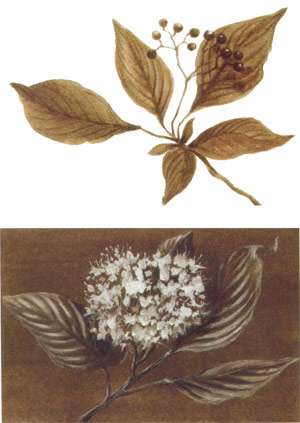
Alternate-leaved dogwood can withstand considerable shade and is common in the forest understory, especially where soils remain moist. But in dim light, beneath a forest canopy, it rarely puts on the good flower show that occurs where sunlight is more plentiful. In forest openings, in hedgerows, along the road, or in the yard, this small tree often flowers and fruits prolifically. The cream-colored flower clusters are very showy, but when I see them at the end of May, my thoughts jump ahead to late August, when blue-black fruits will cover the branches. This is because of some pileated woodpeckers that I watched many summers ago.
That year the slender upper branches in a sunlit patch of alternate-leaved dogwood near our house were heavy with berries. When two pileateds tried to land, it was too much for such an insubstantial structure, and the branches flopped. The birds flapped and flapped, and their huge wings even sent some leaves and berries flying as they struggled to keep a foothold on the waving branches. Their persistence was a good indication that the fare was worth pursuing; one or both of them kept coming back until the fruits were completely gone a couple of days later.
Scores of other bird species eat the fruits, and for many of them, this dogwood is a favorite. Grouse and wild turkeys are among the fruit-eaters, and these two species also eat the buds in winter. An old name for the tree is pigeonberry, supposedly from having fed passenger pigeons. It gets high marks as a multi-species favorite: the fruits are popular with bears and the twigs are browsed by deer. Many birds choose alternate-leaved dogwood for nesting.
Though unlike all the other native dogwoods in having alternate, rather than opposite, leaves, the leaf of this species is otherwise dogwood-like: simple, oval, and with a long-pointed tip. The slightly sunken veins originate from a midrib but, instead of going to the leaf margin, they curve and run nearly parallel to the margin, heading towards the tip, a pattern called “arcuate venation.”
Although technically the leaves are alternate, they have such a strong tendency to cluster near the branch tips that they appear to grow in whorls. The branches themselves do indeed grow in whorls, horizontally from the trunk and sometimes in distinctly stratified tiers, earning the tree another of its common names, pagoda dogwood. In the absence of pileated woodpeckers, this is the most striking feature of the tree. The small, leaf-bearing twigs curve upwards from the horizontal branches, mostly at the outer ends, creating a shape very unlike any other tree. Once you notice its unusual architecture, you will easily recognize a classic specimen from afar.
The stems are variable in color when young, ranging from green through purple and on to brown. Older and larger stems are gray, but “large” for an alternate-leaved dogwood is but 3 to 6 inches in diameter. Twenty-five feet is a respectable height. The leaves sometimes turn a beautiful reddish purple before they drop in autumn, though this, too, is quite variable.
In late May, the 3-inch-wide flower clusters get mixed reviews on the subject of fragrance. Nurseries offering this tree for sale describe the scent as “light” and “sweet.” For those without a pecuniary interest, “sickeningly fragrant” is a more typical description. Insects agree with the nurserymen, and on sunny days, the flowers will be busy with pollinators. As the green fruits ripen to blue-black, the fruit stalks turn bright pinkish red and sometimes stay showy well into winter.
Alternate-leaved dogwood grows throughout most of the eastern U.S. and southeastern Canada but is most at home in the northern part of its range. Adequate moisture is even more important in warmer climes.
Anyone who investigates this plant will soon notice that many times the dead branches are a distinctive bright orange-yellow color and speckled with orange fruiting bodies, the hallmark of a fungus called golden canker (Cryptodiaporthe corni). Generally, this disease does not seem to be lethal, unlike the deadly dogwood anthracnose that is a notorious killer of flowering dogwood. Fortunately, that fungus does not affect alternate-leaved dogwood.
Green osier is another – and much less burdensome – name for alternate-leaved dogwood. If I weren’t such a slave to the authority of field guides, I’d switch to that.
Usually green osier is one of the more subtle elements of the forest, most often unnoticed and in the background. But once in a while, the strongly horizontal, tiered branches and the distinctive way in which the leaves are held will startle you with their unusual beauty.


Discussion *